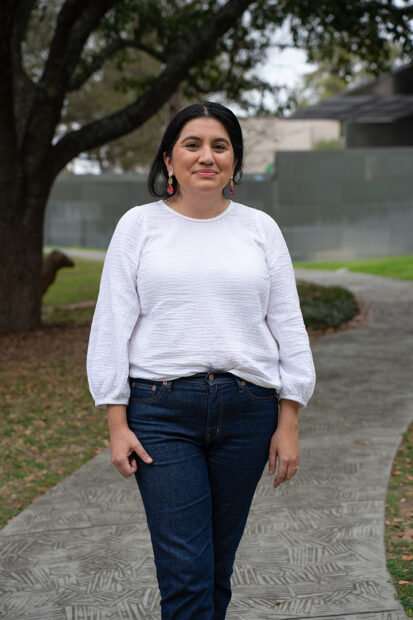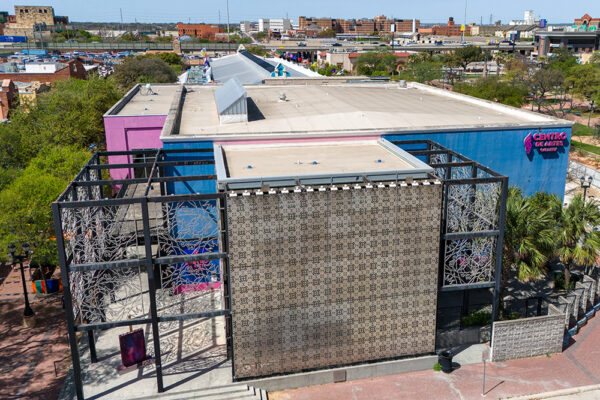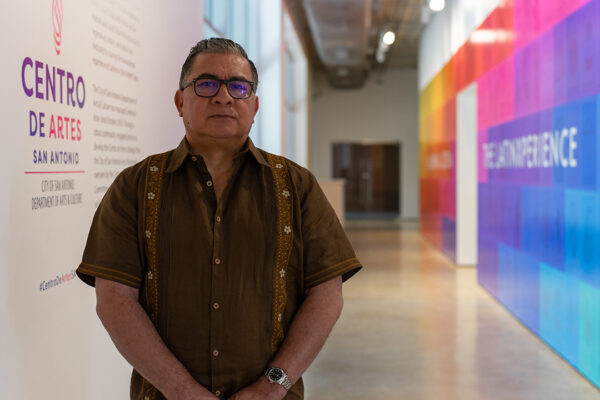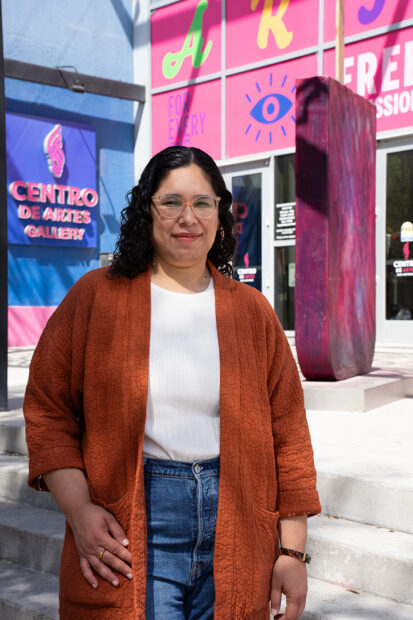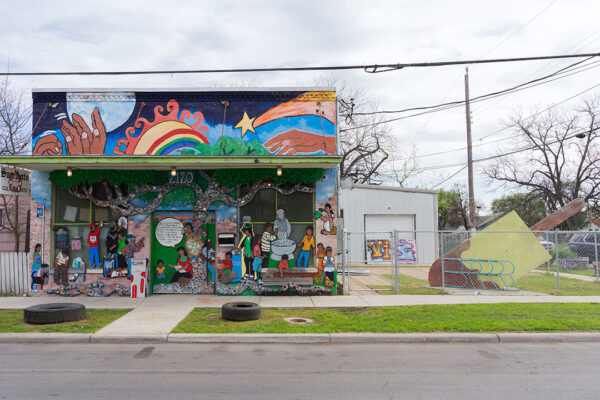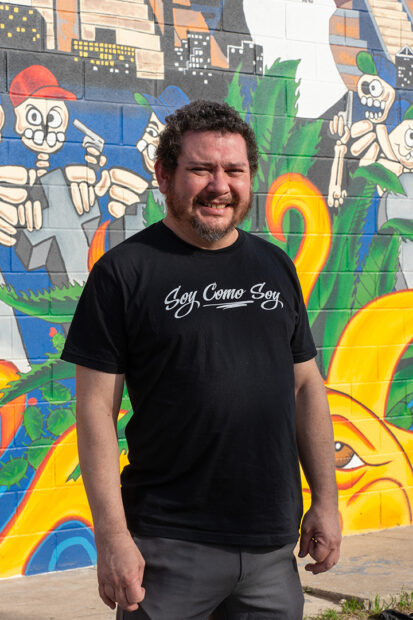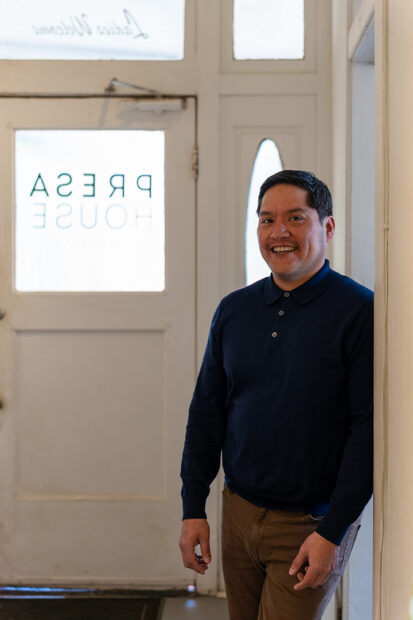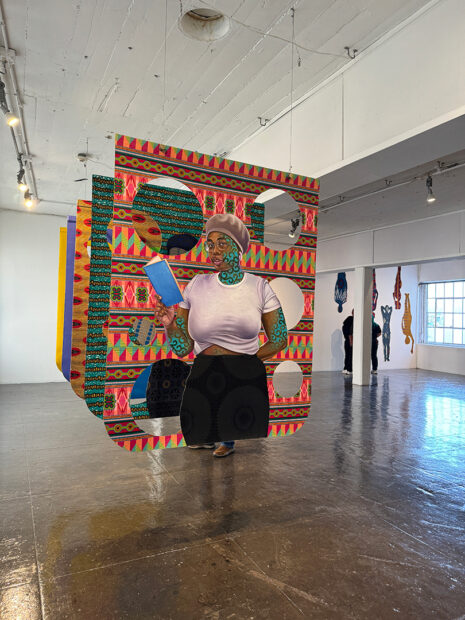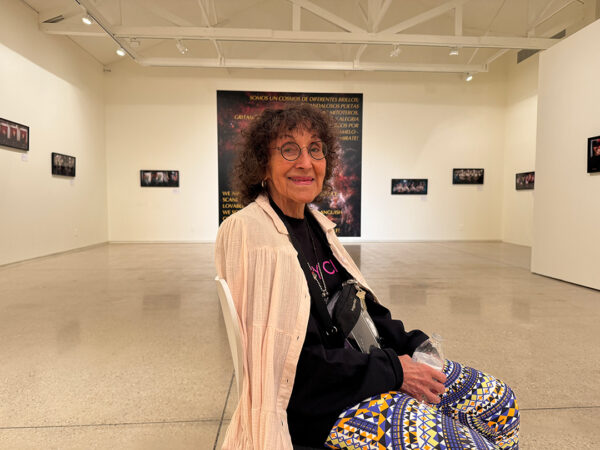Author’s Note: This is the second in a series of articles about my travels related to a series of articles I am writing that are funded by the Andy Warhol Foundation’s Arts Writers Grant.
Following my Austin trip in January to learn more about the founding of the Mexic-Arte Museum, San Antonio was at the top of my list of next places to visit as I travel the state learning more about local art spaces created by and for artists of color. Being a majority-Latino city, San Antonio has a deep history of culturally specific arts institutions. There are many places and people to learn about, and though I have visited the city three times in the last two months, I feel I am only scratching its surface. These trips have included interviews as part of my research into BIPOC-led arts organizations and have also been focused on my broader work at Glasstire of learning and writing about art happening across the state.
In early February, I made my way to San Antonio to attend Artpace’s welcome dinner for its Spring 2024 resident artists. While I often write about the newly announced Artpace residents and the events surrounding their residencies, I hadn’t yet attended one of the organization’s welcome dinners. It was exciting to hear directly from artists Melissa Joseph, Patrick Quarm, and José Villalobos about their previous work and to feel the energy building in anticipation of the start of their residencies. All three artists noted that while they’re excited, they feared the roughly two-month residency would fly by.
I also spent time with Elyse Gonzales, Director of Ruby City; met Patricia Morales, Ruby City’s new Head of Public Engagement & Communications; was introduced to Hank Lee, founder and owner of San Angel Folk Art Gallery; and spent time informally chatting with Rigoberto Luna, co-founder of Presa House Gallery. The conversation with Luna served as information gathering for my future San Antonio visits. We spoke about Presa House and about the project I am pursuing through my Warhol grant. And the short visit to San Angel lit a spark of curiosity to return and learn more about Lee’s gallery.

Hank Lee shows two guayaberas at San Angel Folk Art Gallery in San Antonio. Photo by Raul Rodriguez.
Then, in early March, photographer Raul Rodriguez joined me in a whirlwind weekend trip where we interviewed and photographed Mia Lopez, the inaugural Curator of Latinx Art at the McNay Art Museum; Sebastian Guajardo and Stephanie Torres, employees at Centro de Artes; Juan Ramos, a co-founder of San Anto Cultural Arts; Rigo Luna; and Hank Lee.
Speaking with Lopez (and also Claudia Zapata) had been on my mind since her appointment to the new grant-funded position at the McNay, which is part of the Leadership in Art Museums (LAM) initiative, which supports museums’ efforts to address racial equity within leadership positions. In this incredibly fruitful conversation, I learned more about Lopez’s professional path and her continued interest and research into the terms (Latino, Latina, Latin@, Latinx, Latine, etc.) that people of Latin American descent use to identify themselves. (This interview will be published in the coming months.) During my time talking with Lopez I also wanted to learn more about her time at Museo Alameda. The Alameda has a tricky history in San Antonio. It does not fit neatly into the scope of my article series about art spaces created by artists of color because it was a larger initiative supported by activists, businesspeople, and government officials, but it is an important piece in understanding the trajectory of many San Antonio art professionals and artists. It was the first Smithsonian affiliate and garnered a lot of support and excitement from the local community. However, the organization was only in operation for five years. There is much to know about the Alameda, and I am working on a more thorough telling of its history, but for now, I’ll leave it at that.
The building that was once home to the Alameda is now Centro de Artes, a city-run arts organization. Having spent most of my life in North Texas, Centro de Artes only came onto my radar because of the exhibition Soy de Tejas: A Statewide Survey of Latinx Art, curated by Luna in 2023. Since then, I have returned to see other exhibitions presented by Centro and enjoyed the opportunity to talk with Sebastian Guajardo and Stephanie Torres about the history of the space. Though the Alameda did not last, it is safe to say that many of the dreams of what that institution could be, in particular what it could be to local artists, are alive and well in Centro de Artes.
Since opening in 2016, Centro has hosted 25 exhibitions, featuring a total of 514 artists. Each show is curated by a guest, whose exhibition is selected through a proposal process. The process itself has also evolved over the years to include a selection committee made up of artists, arts professionals, and community members who review exhibition proposals and make recommendations to the staff. The exhibitions showcase an array of Latinx artists working in a variety of mediums who are based locally, regionally, nationally, and internationally. Again, there is more to share about this organization’s history, which I will do in a future article.
I also spent time chatting with Juan Ramos, who along with Manuel Castillo and Cruz Ortiz helped found San Anto in 1993. Ramos was modest about his involvement in establishing the organization, but he shared some anecdotes about how the idea of painting community murals with a DIY mindset evolved into a broader initiative to support San Antonio’s Westside. We met at a coffee shop and following our conversation visited San Anto. The small, seemingly innocuous space was brimming with volunteers setting up tables in preparation for a program. I spoke briefly with some staff members who I am continuing to chat with about the current state of the organization.
Then we walked down the street to see one of the nearby murals that Ramos painted. During our talk, Ramos discussed the legacy of San Anto as being more than the beautification of the area, noting that it is an investment in the community. He pointed to artists who came up through the program, including Luna.
And this is one of the throughlines and necessary stories about culturally-specific institutions: they often serve as an incubator for young artists and arts professionals of color. Like Lopez, Luna worked at Museo Alameda, but Luna also got his start at San Anto, as a 16-year-old kid looking for ways to engage with art. Luna spoke about Castillo’s support of young artists and how the students were given a lot of authority and space to make decisions and truly be a part of the organization. Additionally, he pointed out how transformative it was for them to be working alongside artists like Cruz Ortiz and to be in the same circles as Jesse Treviño.
Luna talked about the various art experiences that led him to establish Presa House with his partner Jenelle Esparza, who is an art educator and multidisciplinary artist in her own right. Following his participation in San Anto, and with support from Castillo, Luna eventually made his way to study art at Pratt Institute in Brooklyn. He spoke about how, though he was there as an artist, one of the first small-scale things he did was curate an informal exhibition of sketches by his peers. He talked about his time in New York following graduation and the decision to return to San Antonio. Though in the moment, he thought it would be a short-lived return home to regroup, he found that San Antonio held much promise for him.
Luna got involved with doing graphic design for Museo Alameda and, after it closed, he stayed on with the next organization to use the space, Texas A&M San Antonio, and then worked with Centro de Artes as well. He also worked with Blue Star Contemporary (now the Contemporary at Blue Star) assisting with installation and designing graphics. At Blue Star, Luna learned more about installing art and grew his art network. He shared a bit about the precursor to Presa House: in 2013 the space was a hair salon, and Luna started by rotating artworks in the salon’s hallway. The next three years a lot unfolded for everyone involved with the salon, which eventually led to Presa House becoming its own space, dedicated to art and music, with a DIY approach.
Over the last eight years, Presa has focused more on visual work and has become an important art space in San Antonio. But beyond Presa, Luna has also been curating shows at venues outside of his home town. In 2022, he was a co-curator for Son de Allá y Son de Acá in Albuquerque, New Mexico. The following year, he co-curated John Guzman: Flesh and Bone at the Blaffer Art Museum in Houston, and the exhibition Son de Allá y Son de Acá which traveled to Chicano Park Museum in San Diego. This year, Soy de Tejas opens in Fort Worth, and Luna will curate a solo exhibition of works by Jose Villalobos at Art Yard in Frenchtown, New Jersey.
I ended my time in San Antonio by interviewing Hank Lee and learning more about his life and his gallery, which has been located in the Blue Star Complex for 35 years. Throughout the conversations it was evident that San Antonio has a rich, long, interwoven history of arts organizations. As an outsider, it has been interesting to piece together all of the stories, and yet I know there is still much more to know and understand about the spaces that make up San Antonio’s art scene.
My most recent trip to San Antonio was at the end of March, and it was the Artpace residency program that brought me back again. The artists who I heard from in February had an opening reception for their exhibitions and the guest curator, Larry Ossei-Mensah, moderated a panel discussion with the artists about their time at Artpace. It was a full-circle moment to come back and see the work they completed over the past two months and to hear them speak about the experience of connecting with the city and each other through the residency.
My March trip also included a chance to meet and interview Celia Álvarez Muñoz. Born in El Paso, Muñoz has been based in Arlington for a long time, and though I am also in North Texas, we have never had the occasion to meet before now. Last year, Ruby City announced that it acquired 18 prints from Muñoz’s Semejantes Personajes/Significant Personages series, depicting San Antonio Latinx artists. Created in 2002, the works serve as an archive of the area’s art scene at the time and feature artists such as Terry Ybanez, Chuck Ramirez, Mel Casas, Ethel Shipton, Alex de Leon, Cruz Ortiz, and Ana de Portela, among others. It was inspiring to speak with Muñoz and hear about her experience of getting her MFA at the age of 40, balancing motherhood with her art career, and the network of supporters she has gained across her lifetime. (A full interview with Muñoz is forthcoming.)
In regards to the Warhol Foundation-funded article series, I’m still deciding what I’ll do next. I feel the need to dive further into San Antonio, as I know there are still institutions I have not connected with, and I am eager to set plans to travel to other cities and learn about their organizations, past and present, helmed by artists of color.


